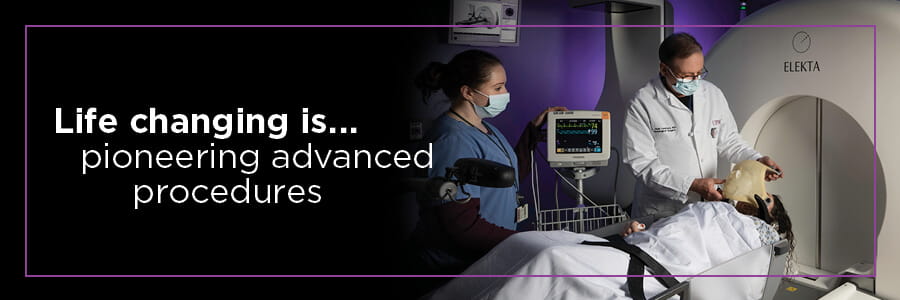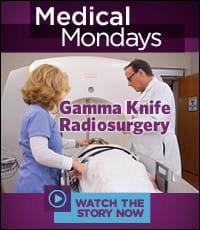If you have a tumor or other anomaly in your brain, your doctor may suggest Gamma Knife® radiosurgery.
Despite its name, a Gamma Knife procedure isn't surgery.
Rather, it's a painless treatment that uses radiation beams to target tumors and lesions. There are no incisions or stitches in Gamma Knife treatment.
What Is Gamma Knife Radiosurgery?
Gamma Knife radiosurgery is a non-invasive and highly precise radiation treatment for brain tumors and other issues.
Highly focused gamma rays target the affected part of the brain while lessening exposure to surrounding healthy tissue.
What Is the Gamma Knife Used For?
Our experts in Gamma Knife radiosurgery at UPMC can treat an array of brain disorders.
The results after Gamma Knife treatment differ based on the type of tumor:
How Should I Prep for My Gamma Knife Radiosurgery?
You need to stop eating and drinking by midnight the night before your Gamma Knife treatment.
Ask your neurosurgeon about any prescription drugs you take. They'll tell you what medicines you can and can't take that day.
The day of your treatment:
- Wear comfy clothes.
- Skip hair products like spray or gel. Your doctor may give you special shampoo to wash your hair with.
- Don't wear jewelry, hair pieces, makeup, or nail polish.
- Remove contacts, glasses, and dentures.
- Bring a loved one who can drive you home.
Prepping you for your Gamma Knife surgery
Before the treatment begins, doctors will:
- Fit you with a circular frame to put your head in the right place.
- Attach this metal frame to your scalp and skull with small pins. You'll get numbing shots, so you won't feel pain from the pins.
- Take pictures of your brain using either CT scans, MRIs, or angiograms. The images will show the exact location, size, and shape of the tumor or other problem area.
What Happens During Gamma Knife Radiosurgery?
The Gamma Knife treatment takes between 20 minutes and several hours. You'll have an IV with medicine to help you relax, but you'll be awake the whole time.
The treatment itself is painless.
Here's what happens during Gamma Knife radiosurgery:
- You'll lie on a table. Doctors will fit a special helmet over the head frame. The helmet has tiny holes that allow precise beams of radiation to pass through.
- The table slides into a machine that delivers the radiation.
- Your head frame and helmet will line up with the machine and click into place.
- Your care team will go to another room. You can talk to them through an intercom. They'll watch you on cameras.
- The Gamma Knife® unit will deliver the radiation. You won't feel anything while this happens.
- The radiation targets the diseased tissue. It leaves healthy tissue around it intact.
What Happens After Gamma Knife Radiosurgery?
Once the treatment is over, doctors will watch you to make sure you recover well. You can eat and drink as soon as you're able.
You may be able to go home the same day as your treatment. You'll need someone to drive you, as the medicine you get can make you sleepy.
If your doctor says it's OK, you can go back to your normal routine the next day.
You may need just one Gamma Knife treatment. Or, based on your health issue, you may need more sessions. Your doctor will give you more details.
What Are the Side Effects of Gamma Knife Surgery?
The side effects from Gamma Knife surgery are typically less than those from standard brain surgery.
Gamma Knife radiation is less likely to damage the healthy tissue around the treated area.
But as with any health treatment, there are risks.
Gamma Knife® side effects may include:
- Fatigue.
- Headache.
- Nausea and vomiting.
- Swelling in the treated area.
- Tenderness and bruising where the head frame attached to your scalp.
Life expectancy after Gamma Knife® surgery depends on your health problem.
Your doctor will want to see you for follow-up tests like MRIs and CT scans. They'll be able to tell you more about your prognosis.
What Is the Success Rate of Gamma Knife Surgery?
Over its 30-year history at UPMC, Gamma Knife radiosurgery has proved effective for more than 18,000 people with:
- Benign or malignant brain tumors.
- Vascular malformations.
- Pain.
- Other functional problems.
Pioneers in Gamma Knife treatment
UPMC installed the first North American Gamma Knife in 1987. Since then, we've introduced and pioneered technological improvements.
Today, the Center for Image-Guided Neurosurgery at UPMC leads the nation in Gamma Knife treatments. It's also a major teaching center for neurosurgeons, radiation oncologists, and health physicists from around the globe.
Leaders in using the latest Gamma Knife models
UPMC is one of the first in the U.S. to use the Gamma Knife Icon™. This is the most advanced model of Gamma Knife radiosurgery.
The GK Icon's cutting-edge technology:
- Allows for a frame-based or frameless approach to radiosurgery, giving surgeons more options when treating complex brain issues.
- Uses radiological images to target areas in the brain more precisely than ever before.
- Offers dosage control and motion management systems to administer treatment with extreme accuracy.























